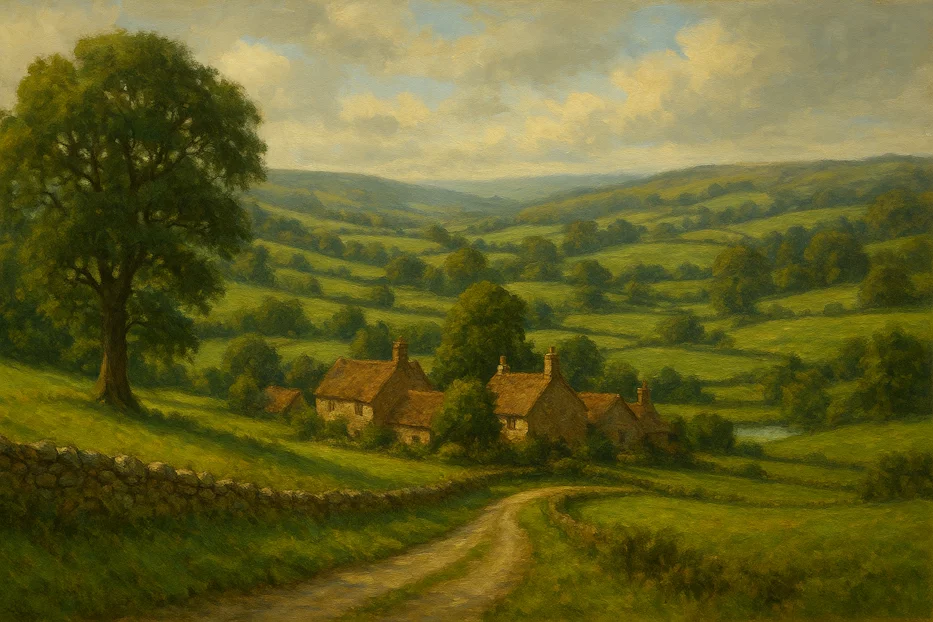The island of Great Britain consists of three distinct countries: England, Scotland, and Wales. Out of these, England stands as the largest in terms of area.
With its varied landscapes, from the peaks of the Lake District to the chalk hills in the south and the dramatic coastlines in the west, England has a rich history and continues to attract visitors from around the globe.
Table of Contents
Geography of England
Covering approximately 130,310 square kilometers (50,310 square miles), England dominates the landmass of Great Britain with a landscape that shifts between flat plains, gentle rolling hills, and, in certain regions, rugged highlands and moorlands.
England’s temperate maritime climate brings mild weather and frequent rainfall, supporting lush, green landscapes and seasonal transformations that define much of its countryside.
Great Britain’s Countries: A Size Comparison
| Country | Area |
|---|---|
| England | 130,310 km² (50,310 sq mi) |
| Scotland | 77,901 km² (30,078 sq mi) |
| Wales | 20,737 km² (8,007 sq mi) |
Stretching over 4,400 kilometers (2,730 miles), England’s coastline is diverse, featuring everything from chalk cliffs in the southeast to rugged shores in the southwest. Inland, the River Thames, flowing through London, is perhaps the most famous river, eventually reaching the North Sea.
Other significant rivers include the Severn—the longest river in Great Britain—and the Trent, both crucial to England’s geography and history. While London is the largest urban area, other major cities like Birmingham, Manchester, and Leeds also shape the country’s industrial and cultural landscape.
These urban centers contrast sharply with the surrounding countryside, where rolling hills, valleys, and numerous national parks protect England’s scenic beauty and ecological richness.
Unique Geographical Features of England
Despite its relatively small size, England boasts a diverse array of landscapes, from rugged peaks to gentle hills, deep forests, and intricate coastlines. Each region carries its own distinct natural features, shaped over millennia by geological forces, climate, and the influence of human history. These unique geographical elements make England a mosaic of scenic diversity and ecological richness.
The Lake District
In the northwest lies the iconic Lake District, one of England’s most celebrated natural landscapes and a designated UNESCO World Heritage Site. Known for its serene lakes, high peaks, and lush valleys, the Lake District is home to England’s deepest lake, Wastwater, and its tallest mountain, Scafell Pike.
The area’s glacially-carved valleys and rugged fells (hills or high land) provide dramatic vistas that have inspired poets, artists, and adventurers alike. The Lake District’s climate, often damp and misty, contributes to its rich green vegetation and thriving wildlife.
Herdwick sheep, a hardy native breed, graze on the fells, and the lakes are home to species like Arctic charr, a rare fish found in only a few of England’s deepest lakes. Throughout the year, the Lake District’s weather changes frequently, adding a mystique to the region that draws nature lovers from all around the world.
The Pennine Chain
Known as the “backbone of England,” the Pennine mountain range stretches from the Peak District in the south to the North Pennines and beyond. This limestone and gritstone range features dramatic moorlands, open heaths, and ancient stone walls that divide its landscapes.
The Yorkshire Dales, part of the Pennines, are known for their green valleys, limestone pavements, and winding rivers that cut through the hills, creating picturesque gorges and waterfalls. In the north, the North Pennines Area of Outstanding Natural Beauty offers sweeping heather moorlands, wild landscapes, and habitats for rare species such as the black grouse and red squirrel.
This region, dotted with remnants of ancient mines and stone villages, has retained much of its rugged charm and traditional way of life.
The Cotswolds and South Downs
Moving south, the Cotswolds and South Downs represent England’s classic pastoral landscapes. The Cotswolds, famous for its honey-colored stone villages, gentle hills, and winding country roads, is one of the most quintessentially “English” landscapes.
The limestone-rich soil of the Cotswolds supports vibrant meadows, wildflowers, and ancient woodlands. Its rolling hills, known locally as “wolds,” are crisscrossed by dry stone walls that date back centuries. Further south, the South Downs offer a landscape of chalk hills that roll gently toward the sea.
This region, protected as a national park, is known for its vast open grasslands, called chalk downs, and dramatic white cliffs along the coast, including the famous Seven Sisters and Beachy Head.
The chalk hills support a rich diversity of wildflowers, including rare orchids, which attract numerous butterfly species.
The Moors of Dartmoor and Exmoor
The southwest of England presents a wilder, more untamed landscape, particularly in the moors of Dartmoor and Exmoor. Dartmoor, with its vast granite tors, or rocky outcrops, is a striking landscape of rolling hills, open heaths, and mysterious stone circles.
This rugged terrain is dotted with ancient standing stones and the remains of medieval settlements, giving it a sense of timelessness. Exmoor, though smaller, is equally captivating with its heather-covered hills, wooded valleys, and dramatic coastal cliffs.
Both Dartmoor and Exmoor are known for their wild ponies, hardy animals that roam freely across the moors. The moors also offer dark skies, attracting stargazers seeking views of the Milky Way, which is visible on clear nights away from urban lights.
The Norfolk Broads and East Anglia’s Flatlands
The eastern region of England is dominated by the flat expanses of East Anglia, with its fertile agricultural land and distinct marshy areas. The Norfolk Broads, a unique network of rivers, lakes, and fens, provide an intricate wetland landscape unlike any other in England.
Originally created by medieval peat diggings that filled with water over time, the Broads now form a diverse ecosystem, home to rare birds, dragonflies, and aquatic plants.
In this region, open fields and expansive skies create a tranquil setting, often described as “big sky country” due to the low horizon and panoramic views. The gentle countryside, along with the region’s quiet rivers and reed beds, supports a variety of wildlife, including otters and bitterns, a rare wetland bird with a distinctive call.
The White Cliffs of Dover
England’s southeast coastline is renowned for the White Cliffs of Dover, one of the country’s most recognizable natural landmarks. These cliffs, formed from layers of chalk, rise up to 110 meters (350 feet) above the English Channel, creating a stunning white facade visible from the sea.

Beyond their natural beauty, the cliffs have significant cultural and historical importance, symbolizing England’s natural defense and maritime heritage. The chalk cliffs support hardy coastal plants and a variety of seabirds, such as fulmars and kittiwakes.
The area around Dover is rich in coastal flora and fauna, creating a vibrant ecosystem that thrives on the cliff edges and nearby downs.
Natural Phenomena in England
England’s varied climate and geography give rise to several natural phenomena that, though less dramatic than those found in more extreme environments, are nonetheless significant to the country’s ecological character and seasonal rhythms.
Changing Seasons and Autumn Colors
England’s temperate climate brings four distinct seasons, each with its own charm and natural spectacle. Autumn, in particular, transforms England’s woodlands into a tapestry of red, gold, and amber as deciduous trees like beech, oak, and maple shed their leaves.
Places like the New Forest, Forest of Dean, and Sherwood Forest are popular destinations to witness these vibrant autumnal colors. The arrival of autumn also coincides with seasonal migrations, as bird species like swans, ducks, and geese arrive from northern regions to spend winter in England’s wetlands and estuaries.
Spring Bluebells
Springtime in England heralds the arrival of bluebell season when carpets of bluebell flowers bloom in ancient woodlands across the country. These delicate, bell-shaped flowers create a sea of blue under the fresh green leaves of spring, filling the air with a sweet fragrance.

Bluebell woods are one of England’s most cherished natural displays, particularly in forests like Ashridge, Hallerbos, and the woods of the Cotswolds.
Frost and Misty Mornings
Winter in England brings chilly, crisp days and the occasional snowfall in northern and higher-altitude areas like the Lake District and Pennines. Though heavy snowfall is rare, winter often covers England’s countryside in frost, creating picturesque scenes of crystalline trees and frozen fields.
Mist and fog are common during colder months, particularly in river valleys and lowland areas, where they create atmospheric, often haunting landscapes. Morning mist is especially frequent in autumn and winter, hanging over rivers, lakes, and fields, giving an ethereal quality to the countryside.
These misty mornings add to the tranquil beauty of areas like the Lake District and the Norfolk Broads.
Coastal Erosion
England’s coastline, shaped by the forces of erosion, is constantly evolving. Coastal erosion is particularly evident along the east coast, where the soft cliffs of East Anglia and Yorkshire face constant pressure from the North Sea.
Areas like Holderness and the Suffolk coast experience some of the highest erosion rates in Europe, with land slowly wearing away over time. While erosion presents challenges for local communities, it also reveals ancient fossils and geological features, particularly along the Jurassic Coast in Dorset and East Devon.
This UNESCO World Heritage Site is famous for its cliffs, which expose layers of rock dating back millions of years, providing a glimpse into the earth’s history.
Rain and Milder Climate
With its temperate maritime climate, England experiences rain throughout the year, with wetter conditions in the west due to the prevailing Atlantic winds. The Lake District is known for its heavy rainfall, creating lush green landscapes and sustaining the region’s numerous lakes and streams.
Rain showers, often interspersed with sunshine, contribute to the country’s verdant countryside and productive farmlands. While England’s weather is unpredictable, it rarely reaches extremes, resulting in a milder climate than many regions at similar latitudes.
This moderate weather allows for the growth of rich vegetation, from grasslands to ancient woodlands, across the countryside.
A Landscape of Natural Beauty and Subtle Phenomena
England’s landscapes may not feature towering mountains or tropical rainforests, but they possess a unique, quiet beauty defined by gentle hills, ancient forests, and windswept coastlines.
The interplay between England’s varied topography and temperate climate creates a rich natural tapestry that has inspired poets, painters, and explorers for centuries.

Practical Tips for Visiting Great Britain’s Largest Country
Getting There
England’s connectivity is unparalleled, whether you’re arriving by air, sea, or rail. London’s Heathrow Airport serves as a major international hub, complemented by Gatwick, Manchester, and Birmingham, all offering extensive global routes.
For travelers from mainland Europe, the Eurostar high-speed rail connects Paris and Brussels to the heart of London in just a few hours, a seamless and sustainable alternative to flying.
Ferries provide an atmospheric and often scenic way to arrive. Routes from Calais to Dover offer the iconic sight of England’s famed white cliffs, while Portsmouth welcomes vessels from Spain, France, and the Channel Islands.
Ireland is linked via Holyhead and Liverpool, making maritime travel both practical and enriching. If you’re arriving by car, note that England drives on the left, and toll roads, while few, require careful navigation.
Direct Ferries
Routes, Schedules, Prices
Ferries to UK
Travel Around England
England’s transport infrastructure is among the most developed in Europe, combining speed, efficiency, and charm. The national rail network is the backbone of intercity travel, with high-speed trains linking London to cities like Birmingham, Manchester, and Bristol in under two hours.
Regional services, such as the picturesque Cotswold Line or Cornwall’s scenic branch lines, reveal England’s pastoral beauty. For booking and planning train journeys, Rail Europe offers a convenient platform to check schedules and fares. For shorter journeys, buses and coaches provide an affordable alternative, with National Express and Megabus connecting smaller towns.
London’s public transport system is iconic: the Underground, buses, and riverboats form a network that caters to locals and visitors alike. In smaller cities like Oxford or Cambridge, bicycles are a favored mode of transport, while walking allows you to savor the layered history of places like York or Bath.
For rural exploration, such as in the Lake District or the Yorkshire Dales, hiring a car offers flexibility, though narrow roads and weather can pose challenges. Ridesharing services, though less ubiquitous outside cities, are available in many urban centers.
Best Time to Visit Great Britain’s Largest Country
England’s seasons shape its character, and the timing of your visit can define your experience.
Spring (March to May) unveils gardens bursting with life, from the rolling daffodils of the Cotswolds to Kew Gardens’ botanical displays. It’s a season of renewal, with temperate weather ideal for walking tours or countryside escapes.
Summer (June to August) is England’s busiest period, bringing warm temperatures and long daylight hours. It’s the perfect time to enjoy coastal retreats like Cornwall or Brighton, or cultural festivals such as the Proms in London. Be prepared, however, for higher prices and crowded attractions.
Autumn (September to November) transforms the countryside with rich hues of amber and gold. This is an excellent time to explore woodland trails or savor England’s culinary traditions in its renowned gastropubs. Cities like London and Manchester are vibrant yet less crowded, making it a favorite season for many seasoned travelers.
Winter (December to February), though often grey and wet, has its own appeal. Festive markets, from Birmingham to York, offer mulled wine and handcrafted gifts, while museums and galleries provide a warm refuge from the cold. Whenever you visit, England’s charm lies in its unpredictability. A sudden rain shower may yield a rainbow over the countryside or lend a cozy intimacy to a historic pub.
Where to Stay
England offers a wide range of accommodation options, from luxury hotels in London to charming countryside cottages in the Cotswolds. For a city experience, you can stay in stylish boutique hotels in Manchester or historic inns in York. If you prefer the coast, seaside resorts in Cornwall or Brighton provide stunning views.
Budget travelers can opt for cozy B&Bs or hostels, while those seeking a unique stay might enjoy castle hotels or glamping in the Lake District. Wherever you choose, England has something for every traveler!

